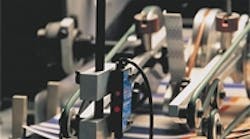Quick. Name a device you can use to measure motion. If you answered "encoders" or "resolvers," you have plenty of company. Among engineers, encoders are most often associated with the detection of motion. However, these devices detect a specific kind of motion, such as how far an axis moved or how many revolutions a shaft has spun. They are not as well suited to discerning whether objects are moving along a conveyor.
For these and other such applications, proximity sensors are a better choice, having the ability to detect the presence or absence of objects. Inherent in this function, though, is the ability to detect motion, allowing such devices to meet the needs of a range of motion applications, including a few where encoders are the first thing that comes to mind.
Time pieces
Occasionally, an encoder has more functions and capabilities than an application needs. For these situations, proximity sensors can provide an alternative. Finding motor-shaft speed is an example.
If there's a keyway on the shaft, a proximity sensor can clock how fast it is rotating to determine shaft speed. As the shaft turns, the keyway comes in and out of the sensor's field of view. When the sensor detects the keyway, it provides an output, basically pulsing every time the keyway goes by. This pulse train may go to a PLC, which can use it to determine how fast the shaft is moving.
"A proximity sensor can function like a crude encoder," says Jim Drew, senior product engineer, Allen-Bradley, Chelmsford, Mass. "But, the sensor is not counting anything. All the counting or speed calculation is done in the PLC. This is a good solution for applications that don't require you to measure rotational position." Instead of a keyway, gear teeth, or any kind of metal flag on a rotating cylinder, may serve as the reference point for the sensor.
Photoelectric and proximity sensors can also help synchronize commands given to multiple motors. The pulses the sensors emit when they detect objects moving down a line provide a timing constant. Engineers can use these pulses to set and coordinate the operation of several motor-driven devices. Packaging applications often use this technique to synchronize product wrapping functions.
Occasionally, you can also use proximity sensors in place of encoders in material handling applications, such as a mail handling facility where envelopes continuously stream down a line on a belt conveyor. "In this application, rather than use an encoder to determine belt speed, some engineers have used a photoelectric sensor," says Allen- Bradley's Dave Hagemeier. "You'll need some kind of reference, such as the staples on the belt, that the photosensor can see. Because staples are usually spaced at regular intervals, sensor pulses can replace encoder pulses," he explains.
From there, you'd simply develop a formula that equates a specific number of staples per belt revolution to determine belt speed," says Hagemeier. This sort of measurement can be rather coarse in terms of accuracy, but generally, people are more concerned with detecting increases or decreases in speed, not determining actual speed." While this solution may require more programming than an encoder, it has the benefit of being inexpensive.
Just right
The low cost of proximity sensors is the main reason they are chosen over encoders for these applications. Other factors include their reliability, size, and ease of implementation.
Inductive proximity sensors are a good choice for any environment. These durable devices are generally immune to dust, moisture, harsh chemicals, temperature extremes and weld fields.
They also will reliably sense a target repeatedly. At a sensing distance of 10 mm on a large proximity sensor, the typical repeatability is ± 1%.
Another reason for considering these sensors is their small size. Proximity switches, especially optical ones, can squeeze into locations other motion sensors can't.
Size also affects sensing distance, which diminishes with their dimensions. Proximity sensors generally detect objects at distances from 10 mm down to 2 mm. Dc versions respond more quickly than ac versions, because they can operate at upwards of 3,000 to 4,000 Hz.
Many types of photoelectric sensors can respond even faster than inductive proximity versions. They also offer a longer sensing distance, in some cases up to 900 ft. They are one of the best choices for detecting transparent targets. However, they are less immune to their environment: The photo lens is susceptible to dirt, dust, moisture, and other particulates that can collect on it.
When deciding which sensor to use, the most important factors are the environment and the response speed needed by the application. The variety is large, so check with the manufacturer for the best choices.



